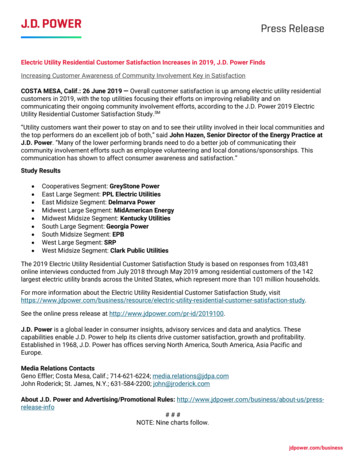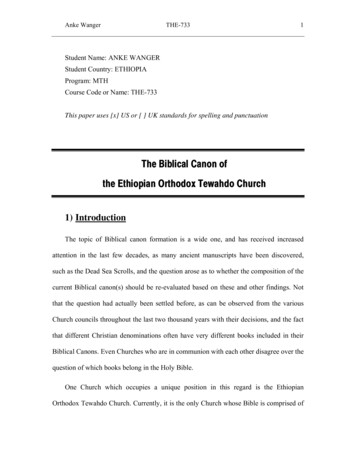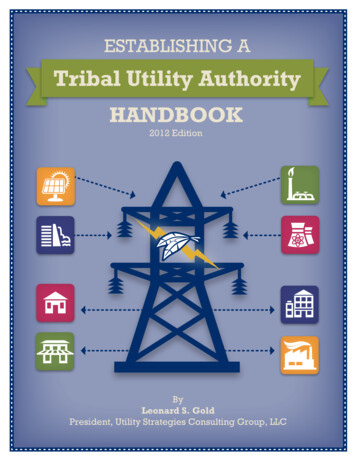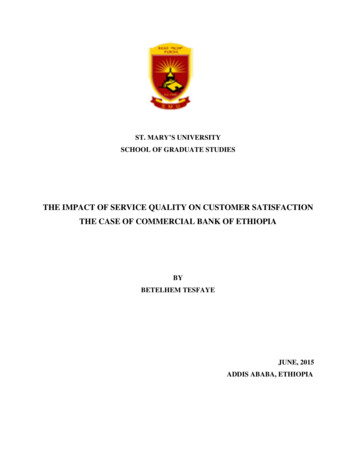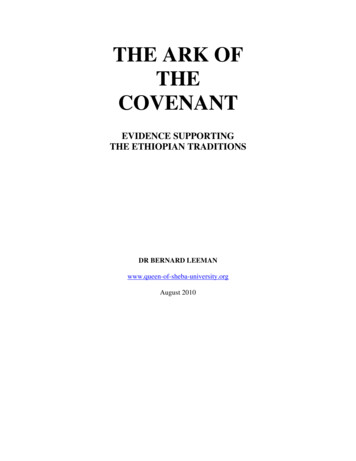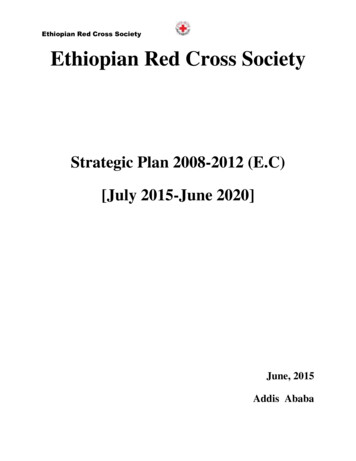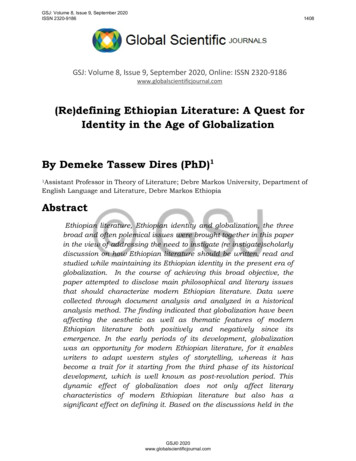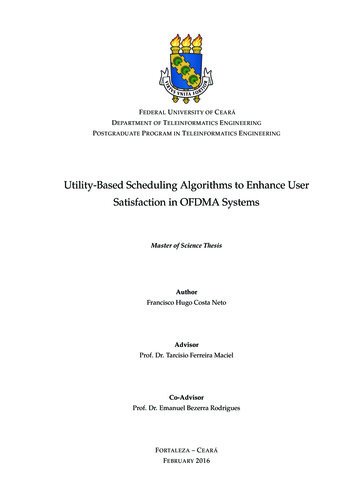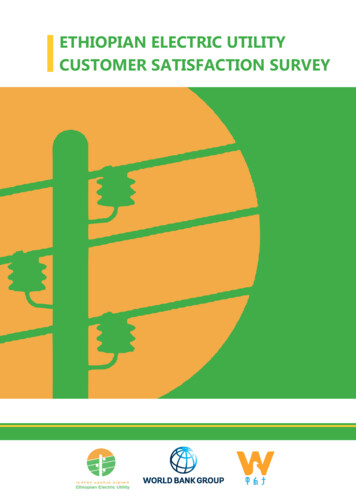
Transcription
ETHIOPIAN ELECTRIC UTILITYCUSTOMER SATISFACTION SURVEY
ETHIOPIAN ELECTRIC UTILITYCUSTOMER SATISFACTIONSURVEYWALTA MEDIA AND COMMUNICATION CORPORATEADDIS ABABAJANUARY2021
AcronymsivE.C:Ethiopian CalendarEEP:Ethiopian Electric PowerEEU:Ethiopian Electric UtilityG.C:Gregorian calendarMRP:Material Resource PlanningSPSS:Statistical Package for Social Science
TABLE OF CONTENTChapter OneIntroduction1.1 Background of the Study1.2 Goal of the Study1.3 Objectives of the Study1.4 Scope of the Study1.5 Limitations of the Study1.6 Organization of the StudyChapter TwoLiterature Review2.1 Definition of Customer Satisfaction and Service Quality2.1.1Quality of Service2.1.2Customer Satisfaction2.1.3Development of General Infrastructure Services in Ethiopia2.2 Electricity Service Development and Supply in Ethiopia2.2.1Theory of Power Development and Supply2.2.2History of Electric Power Development and Supply in Ethiopia2.2.3Existence of Electric Power Development and Supply in Ethiopia2.3 The Concept of ERP2.3.1What is an ERP system?2.3.2Enterprise Resource Planning (ERP)Chapter ThreeResearch Design and Methodology3.1 Research Design3.2 Sample Design of the Study3.3 Method of Data Collection3.4 Method of Analysis3.5 Implementation of COVID-19 Health and Safety Plan3.6 Problems Encountered and Measures TakenChapter FourData Analysis and interpretation4.1 General Information about Respondents4.2 Understandings of EEU Organizational Structure4.3 The Length of Time Being a Customer of EEU4.4 Electric-Meter Type4.5 About a Recent Price Adjustment on the Electric Bill4.6 Proper Utilization of Electric Power4.7 Demand for New Electric Service and Customer Service4.8 Postpaid, Electric Use Counter Reading and Participants’ Opinion4.9 Service Provision4.10 Prepaid Billing Service4.11 Grievance Presentation and Handling Procedure4.12 Power outage notification4.13 Electrical Injuries and Participants’ Comments4.14 Modern Operating System4.15 Frequency of Power Outage4.16 The Existence of Gender-based Discrimination in Service Centers4.17 Implementation of a transparent and accountable system4.18 Overall Customer Satisfaction4.19 Gaps/Weakness/and strengths of EEU4.20 Summary of Comparison with the Results of Last year’s StudyChapter FiveMain findings and conclusive Remarks5.1 Main Findings of the Study5.2 Conclusive RemarksAnnex 1: QuestionnaireAnnex 2: Technical Committee Meeting v
CUSTOMER SATISFACTION SURVEYCHAPTER ONEINTRODUCTION1.1Background of the StudyOne of the most important issues for the development of a country is the availability of a reliable power supply.It’s not possible to create a competitive economy in the world without ensuring competitive power supplyservices in terms of supply, quality, service efficiency, and price. This in turn will help sustain the competitivestance and development of a country on the global stage.The electricity development history of Ethiopia dates back to the late 19th century. During these times, multipleengagements aimed at boosting the role of the sector, improving sectorial investment improving the accessibilityof electricity, and thereby increase the economic competitiveness of the country have been done. The deep gapin service requirement and prevailing supply enrolled multiple government agencies to engage themselves intrying to alleviate the power supply problems of Ethiopia.Following the 1991 revolution, the newly established government developed the first power supply policy. Thekey focus in the document was to boost overall energy generation, transmission, and distribution activities tocope up with the growing energy demand in the country. Supporting guidelines and revised strategic approacheswere developed to aid the increase in the electric coverage of the country. The many efforts centered on realizingthe dual aim of fueling the fast economic development of the country as well as increasing the export earnings.Employing the untapped energy potential of the country, significant achievements have been materialized andencouraging results have been registered.The sector, in general, has proved to be the backbone of the country’s fast economic growth in the past decades.In addition to building multiple dams across the country, much has been done to improve the accessibility ofelectricity. Associated with power generation, nearly 10 power dams have been built in the last two decades.With this, the country›s total power generation capacity has more than tripled.By far the most glorified structure in the history of power generation in the country, the Grand RenaissanceDam/GERD/ is under construction and is believed to satisfy the unquenched thirst for power both in thecountry and in the region as well. Upon completion, GERD and other power plants under construction areexpected to increase the overall capacity by more than six times.The industry as a whole as it’s solely owned and operated by the government has been facing both intuitional andeconomic-based challenges. Inability to adequately and effectively cover the power supply demand, difficulty to copeup with the growing service requirement, sluggish and often prolonged construction project management, and limitedfinancial ability as almost all funds are generated from the government, and protracted and often limited internationalsupport via grand and aid. Aiming to address these age-long and deep-seated problems and better serve the public, theEthiopian Electric Power Corporation has made organizational structural changes based on research.The effect was establishing a two-winged approach to systematically address the above-raised problems. Taskedwith power generation goal/infrastructural development/, Ethiopian Electric Power (EEP) and shouldering thedistribution and service segment, Ethiopian Electric Utility was established in 2009 with the recommendationof House of Ministers which was established by Regulation No. 303/2006. The five main objectives of EEU areprovided in the regulation. The Ethiopian Electric Utility (EEU) has been in line with the country’s overall1
ETHIOPIAN ELECTRIC UTILITYmanagement structure since 2019/20 to address the power supply problems and created a new decentralizedregional organization. To address the operational limitations and problems of good governance of theinstitution, the Institute is working to better implement the three-pronged approach of decentralization, theuse of automation and technology, and the use of outsourcing strategies. A strategic plan is also planned for thenext ten years. In 2025, with the goal of “Light for All”, 65 percent of the main grid and the remaining 35 percentof the grid are being made available to all. The distribution network is outdated and plans are afoot to upgradeand rebuild it to provide uninterrupted energy supply.The mission of the Ethiopian Electric Service is to provide international quality, reliable and sustainableelectricity service to all consumers at an affordable price by expanding the service with the help of moderntechnology. To this end, the company is currently providing services to customers in accordance with theservice tariff category, with the vision of becoming a competitive electricity service provider that will meet theeconomic and social needs of the middle-income nation in 2025. Today, the institution is providing services toclients subject to the tariff category below.1Table 1: Category: EA Clients by Tariff CategoryTHE WAY CUSTOMERS USE THE SERVICE(TARIFF CATEGORY)NOQUANTITY1For household service2,117,7232For commercial enterprise (total tariff )390,6843Low and medium tariff user customers48,2134For its own office service5Employees of the institution both serving and retired6Customers using prepaid meterTotal2,05529,874546,4893,135,038Furthermore, to make the services technology-enabled and apply general institutional enhancements, it isimplementing various projects designed so far. One of the modern methods that are being implemented isERP. This technology will play an irreplaceable role in modernizing the sales system, financial management,procurement process, service delivery, and billing system of the institution.2Electric utility from household consumption to large factories as well, social and service providers are allbeneficial. The Ethiopian Electric Utility is working hard to make the service available to all citizens fairlyacross the country. Regardless of its efforts, EEU is experiencing continued complaints about its services. Theservice delivery gap both in the supply and quality of overall services is the cause of major customer complaints.Often the expectations are not matched between services they expect and consume. In some places, theseservice complaints have turned into questions of good governance. To reduce and eliminate these problems,as well as to better manage the various activities related to the power supply, to improve the service and adaptto the current needs, the service delivery process and quality, as well as service management competencies, aremain issues that need to be addressed.To better address the above-raised core problems, EEU needs to modernize its operations and adopt newtechnology-assisted practices. Quality of services could be better aided if it alleviates problems related to the122It is taken from the bid document prepared by the Ethiopian Electric mploys-erp-for-59m/
CUSTOMER SATISFACTION SURVEYprocess and modality of service delivery by implementing methods adequate to meet the demand for additionalelectricity and working in close ties with institutions tasked to increase the power supply which is necessary toaddress one of the core problems.The executive body needs to be aware of the complaints and respond appropriately. Overall service satisfactionis better aided if customer’s feedbacks are quickly addressed. Accordingly, Walta Media and CommunicationCorporate and Ethiopian Electric Utility have jointly conducted this customer satisfaction survey requiringwhat the opinion of the users of the electricity service is. The World Bank is also involved in providing therequired budget and overseeing the overall work which was significant to conduct the study.The primary aim of the study is to explore the level of satisfaction of electrical service users. The documentis presented in five chapters. These are the introduction, review of related literature, methodology, analysis ofstudy results, and conclusive remarks an-d summary.1.2Goal of the StudyThe major goal of the study is to identify and evaluate the level of customer satisfaction of the services ofEthiopian Electric Utility (EEU). It is a nationwide inquiry involving a rigorous survey on existing and newenergy consumers using the tariff category, measuring the level of customer satisfaction; identify problemsrelated to service delivery and their solutions. It also tries to learn the root causes of customer dissatisfaction.The findings will help initiate improved service delivery modalities and serves as a basis for corrective actionand input for the preparation of the strategic plan of the institution.1.3Objectives of the StudyGeneral objectiveThe general objective of the study is to measure the level of customer satisfaction on the basic services ofEthiopian Electric Utility provided across the country and suggest directions to improve customer satisfaction.Specific objectives of the studyTo achieve the main objective of this study, the study will have the following specific objectives. They are:To understand the level of Ethiopian Electric Utility service delivery in terms of customers;To know the existence of a customer complaints system in the institutions; know its status in practice;Check the staff and the management of the institution if they are servicing their customers based onethics;To know whether the institution has developed a system to involve the beneficiary community invarious ways.Whether the service is given by the institution is viewed as transparently and faithfully by the customers;Identify points what Ethiopian Electric Utility needs to improve and those that need to be furtherstrengthened;In general, to know the level of customer satisfaction in the provision of the electric utility.3
ETHIOPIAN ELECTRIC UTILITY1.4Scope of the StudyThe study was conducted on customers of Ethiopian Electric Utility, who use power for residential, commercialservice, industry/factory, also categorized as prepaid and post-payment energy users’ views; opinions andsatisfaction level are assessed. The study was conducted in the nine regions and two administrative citiesof the country in selected towns and service centers. The study has employed a well-proven scientific andinternationally accepted research method to shape the design and methodology, determine the size and type ofparticipants in this research.1.5Limitations of the StudyThe main limitations encountered in the study were the short time allotted for the study, and the inability togather information at all selected locations.Only 52 days are given. During this time, it is challenging to complete research at the national level. However,due to the fact that the stakeholders involved in the study were able to corporate and work in a coordinatedmanner, the work was completed on time. Another limitation of the study was the inability to gather informationdue to the conflict in the Tigray region and the security situation in some parts of the country.Tigray State was excluded from the study due to its inability to gather data in all selected cities of the TigrayRegion. However, the sample size was assigned to the nearby regions. So, the study was completed by distributingthe Tigray region’s allocated sample to the Amhara and Afar regions bordering the region. Similarly, due toinsecurity in some parts of the country, data could not be collected; therefore, the sample size to be collected inthose insecure areas were collected in other cities in the same region.1.6Organization of the StudyThe first part of the study document is the introduction chapter. The second part is a literature review, whichincludes a variety of relevant ideas and research findings in the field. In the third part, the methodology ofthe study is presented in detail. In the fourth section, the general study data analysis is presented categorizedinto types, and included in the document. In the last part, the key findings of the study, conclusions, andrecommendations are presented.4
CUSTOMER SATISFACTION SURVEYCHAPTER TWOLITERATURE REVIEW2.1Definition of Customer Satisfaction and Service QualityThe role of the service sector is critical for both developed and developing countries. In particular, for a countrylike ours, it helps to diversify the GDP proportion and balance dependence on agriculture. In order to do that,improving service quality and boosting customer satisfaction is key. This is further escalated at times wherethe said service is sourced from a monopolistic provider. In absence of competition, the need to improve thequality of service should be driven by the organization itself, or else customers have no alternatives but rot inpoor satisfaction. This is not just a matter of for-profit private enterprises, but it is also the main issue for publicinstitutions that provide public services.2.1.1 Quality of ServiceService can be said an activity to the needs of service users, customers, or the general public with a purpose bya government or non-governmental organization to satisfy it (Bekele, 2000 E.C). On the other hand, we find aservice provider, as one that understands the customer’s needs and makes every effort to meet the needs thatindicate. This means that the service provider is a body providing the service correctly understanding whatthe service seeker requests and needs; or it is a concept of action or performance that encompasses all options.When we say service in general, it is any action that the service provider renders, understanding the needs ofthe service user including the performance to satisfy.Service has four different features that are often mentioned. They are: it is an act or performance under theinfluence of the service provider, there may be different circumstances in the eyes of the customer, it variesand is based on the personal feelings of service seekers when it comes to the service seeker, and it is difficult tomeasure (Zini Kemahu). Service is developed by the service provider required to be effective when an action isperformed; we find that it can be improved or reduced due to various internal and external factors.Service is categorized in different levels for different purposes, mainly each in terms of the basics of service;however, it is divided into two parts called material and human services (Zini Kemahu). The material servicepart stands for tangible and physical service delivery process; whereas the one termed human is the intangiblepart of the service. Service providers also have to pay attention to both types of services to provide efficientservices.When we talk about services, it is mainly important determining service seekers’ feelings about the qualityof the service they have received by measuring their satisfaction and thereby improving it; the quality of thesituation is improved by adjusting the requirements of facilitation as one of the most important things andstrategic issues, service providers need to do to succeed in their endeavors. Thus, according to researchersof various studies in the field, it is important to establish a system that ensures the quality of services to staycompetitive in the world market where necessary: this primarily uses what the service seeker expects and meetsthe needs of the service to increase satisfaction.Quality of service, on the one hand, is an attitude about general service attached with judgment: this is theprimary issue which shows the satisfaction of the general service users (Zeithaml and Bitner, 1996). On theother hand, the quality of service of an institution that meets the needs of its customers or is defined as the5
ETHIOPIAN ELECTRIC UTILITYability to provide services that exceed customer needs (Zeithaml et al, 1990). Based on this, the quality ofservice from the users’ perspective of the service is the difference between the level of service delivery that theuser expects from the institution and the fact that s/he received from it.2.1.2 Customer SatisfactionFor the question “Who is a customer of an institution?” many people’s answer mainly focuses on only atindividuals who come to the institution from outside of it in need of its services. However, when we take acloser look at the term customer, the customer is the service seeker(an individual, department, or institution)who comes to buy a service or a product and either to use or sell it to a third party to the facility for transmissionin other circumstances (Bekele, 2000). The concept of customer satisfaction is often a process of measuringhow services meet customer needs when service providers deliver services or products to their users during themarketing relationship they create.Customer satisfaction is a key measure of success in many service provider institutions. It is considered amatter intended to attract customers in the modern world market as a key to differentiating between ongoingbusiness competition and business strategy. It is also considered to measure the level of competition betweeninstitutions. Service providers mainly use customer satisfaction to make their employees pay more attention tomeeting the needs of the customers and achieve institutional goals. As a result of this significant contribution,customers’ proper management of satisfaction is a basic issue in service delivering institutions.In general, the main purpose of institutions measuring customer satisfaction is to understand the level ofmanagerial services and the quality of service providence and suggest points for overall improvement. Withthis, the institutions engage to adequately meet the needs of their customers. Providing this service also allowsthem to increase profits and market shares (Anderson et al. 1994). Besides, customer satisfaction is not limitedto meeting customer benefits, it also includes a wide range of social values, including customer needs, the cost,and nature of services, protects various interests of customers including efforts and a variety of social values,primarily related to human relationships.To provide that institutional services are rendered based on transparency and accountability; at least thefollowing four basic requirements are met. First, what are the services provided by the institutions, and thenaccess the services fulfilling the kind of requirements of service seekers detailed and clear information shouldbe made available to the public. Second, the service seeker who requires the service must meet the requirementsor prerequisites to request the service with the proof that it meets the conditions the nature of the possibility,the facilities to be provided only per the requirements, assessing service providers and providing services; theresult or decision of the service delivery when put it in writing and to make sure that the decision is appropriatewith circumstances to arise or service seekers are unfairly denied service when they create a body and a systemthat provides evidence and responds appropriately.What connects the third with the second issue is if service seekers raise complaints and the one who receivesthe complaint appeals the decision and the reason of the decision gives them in writing and the decision wasmade public through announcement earlier, there is a favorable environment for evaluation. The fourth alsosupervisors of institutions able to ensure that the decision is implemented under the directive where the clienthas the opportunity to confirm this and to implement the control when there is a system and institution thatallows, as well as service seekers in this using a grievance reprisal system to guide the use of systems andinstitutions where employees are being identified and adjusted accordingly. In general, this case shows that theservices provided by government institutions are also being above all of the services they are issues related to6
CUSTOMER SATISFACTION SURVEYgood governance. With this economic, political, administrative, the powers that be and those related to socialand justice issues have become concepts that reflect the process they are implementing.2.1.3 Development of General Infrastructure Services in EthiopiaAccording to the Central Statistics Agency’s population projection of 2009 E.C, Ethiopia has an estimatedpopulation of over 90 million; this makes it the second-largest in Africa. This population is growing rapidlywith an annual growth rate of 2.6 percent. This shows that around 2 million children are born within a year inthe country. According to the information from the African Development Bank, Ethiopia is a country that isregistering rapid urbanization and impressive economic growth (10.3%), (ADB, 2015). According to the WorldBank’s 2019 report, Ethiopia’s economic situation in 2016-17 is lower than in previous years but healthy and asalways has a positive role to play in reducing poverty (World Bank, 2019).To solve the problem of infrastructure and other issues in Ethiopia, national and other horizontal governmentagencies have been taking various measures. Later 1983 A.D, Ethiopia’s market-driven reforms, structural changepolicies, implementing decentralized government structure, and agricultural-led industrial developmentthrough various activities have been made to ensure rapid development and lift the country out of poverty.During these twenty-five years, like any other field, the infrastructure sector has shown rapid development thatthe verification campaign has focused on leading the way in providing services in the sector but remain mainlyas only government responsibilities.The Ethiopian government is following the footsteps of its “developmental state” which plays a strong rolein various economic sectors. This overall direction of government development strategy makes it based oninvesting high-level public sector investment. Accordingly, the country, although the general developmentmovement has a very small foundation since 200, it has been attached with large-scale economic developmentssince 2010. Since then, the government has formed particularly an ambitious program for development andeconomic transition (World Bank, 2017). In these processes, the supply of infrastructure as a sector in thecountry recorded meaningful and tangible achievements in quality and accessibility.2.2Electricity Service Development and Supply in Ethiopia2.2.1 Theory of Power Development and SupplyEnergy is the driving force behind the modern economy. Power is the basis of industrial civilization andthere can be no modern life without it. Industrial, agriculture, mining, and activities on basic services such astransport, communications, and health can be provided when there is an adequate power supply. Therefore, thesupply of energy is very important for economic and social development as such. It should always be availableat a reasonable price. There is no civilization and development without power. The reason for the IndustrialRevolution is the discovery of a source of energy.The presence of steam power contributed to the coming of the industrial revolution in the advent of in theearly 17th century. Using this steam power, Britain, the world’s largest motorist, dominated the manufacturingindustry. The power that gave birth to the Industrial Revolution is the sector and the services it provides. Itstarted running the engines of factories using coal steam power plant that exits in the factory; moving trainsand giant ships began to serve. Thus, in a short period, produced more, production and production inputscould be transported in large quantities and quickly to remote areas. Steam power, in addition to running itsengine, was also used to generate more power. It was possible to generate electricity by running steam turbines.7
ETHIOPIAN ELECTRIC UTILITYThe creation of electricity, not only accelerated the growth of the industry but also made life easier and morecomfortable (B. Negash, 2016).Electric power produced from dams with the help of turbines is transferred and stored to sub-stations wherea high population is found and then distributed from there through transmission lines to reach the users.Transferring and distributing power electric starting from power generation dams or stations, laying of differentsized transmission and distribution power lines, transformers, and in general coordinating institutions todistribute the power for 24 hours ensuring continuous production, requires the engagement of thousands ofprofessionals.2.2.2 History of Electric Power Development and Supply in EthiopiaThe history of electric power development in Ethiopia dates back to the end of the 19thcentury; however, it beganservice to institutions in the first half of the 20th century. The first electric power supply was available from agenerator: it also served only the palace and a limited number of people around it. Besides, the construction ofa dam on the Akaki River was started to generate electricity from the water around 1912 E.C. The main purposeof the source was to provide power and serve many small industries that were thriving in the city. (EEPC, 2002E.C.). This service, which was offered to the industries, was partially available to the public with a need ofexpanding to meeting places and roads.With Emperor Haile Selassie came to power and some degrees of the need for changes and improvementsof government structure and developmental activities, helped to plan the supply of energy to transfer to thehouses and was on due operation; the invasion of Italy at the time, however, stopped including other planneddevelopment projects.After the Italian invading army was pulled out of Ethiopia in 1941, an institution called Administrator ofEnemy Properties was established to carry out various development activities. This institution was given theresponsibility to generate and distribute energy in addition to other works and had been in charge for sometime. This institution handed over the power generation and distribution responsibility in 1948 to an institutionestablished with a name called Shaw Electric Power; the receiving institution had a low capacity but took overthe responsibility of distributing power in all the regions until 1955 and performed various tasks.During these times, the main purpose of the institution was to generate, transfer, and distributed power tothe community; besides, other various activities were required by law to improve the work of the authorizedinstitution and was given the authority and responsibility to do so. At this time, the power generation capacityof the plant reached around 35 megawatts and the general number of customers was not more than 13,000.With the regime collapse of Emperor Haile Selassie due to the political revolution that brought the militaryto power 1967 E.C, the general state of power generation and transmission was also changed to some extent.In connection with this, overall generation, transmission, distribution, and works of delivering power to thepublic were kept under the control of the central government: despite some changes in the service, the modernpower supply, and benefits, however, remain low.When we look at hydropower generations built from the time of Emperor Haile Selassie to the end of the Derg:11 megawatts of Tis Abay in1945 A.D, the Koka Dam on the Awash River which generates 42 megawatts in1952A.D; Awash 2, which generates 32 megawatts in 1958A.D., Awash 3 which generates
4.4 Electric-Meter Type 28 4.5 About a Recent Price Adjustment on the Electric Bill 30 4.6 Proper Utilization of Electric Power 32 4.7 Demand for New Electric Service and Customer Service 34 4.8 Postpaid, Electric Use Counter Reading and Participants' Opinion 36 4.9 Service Provision 38 4.10 Prepaid Billing Service 41
